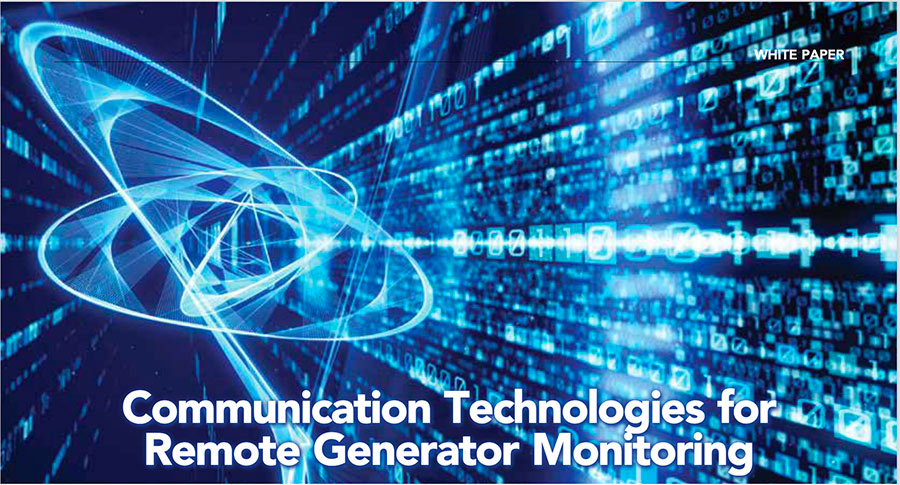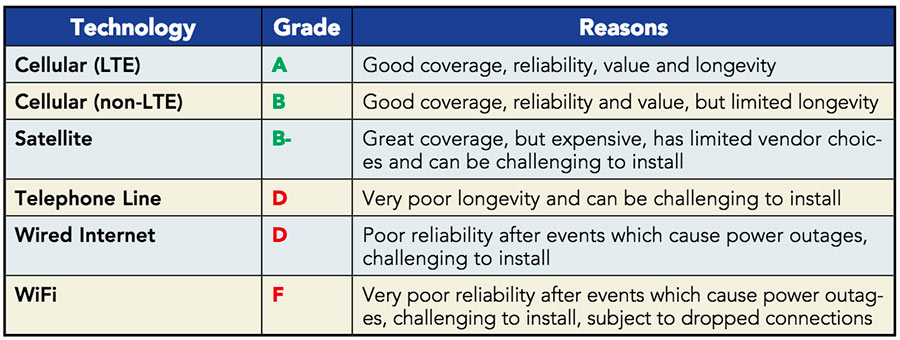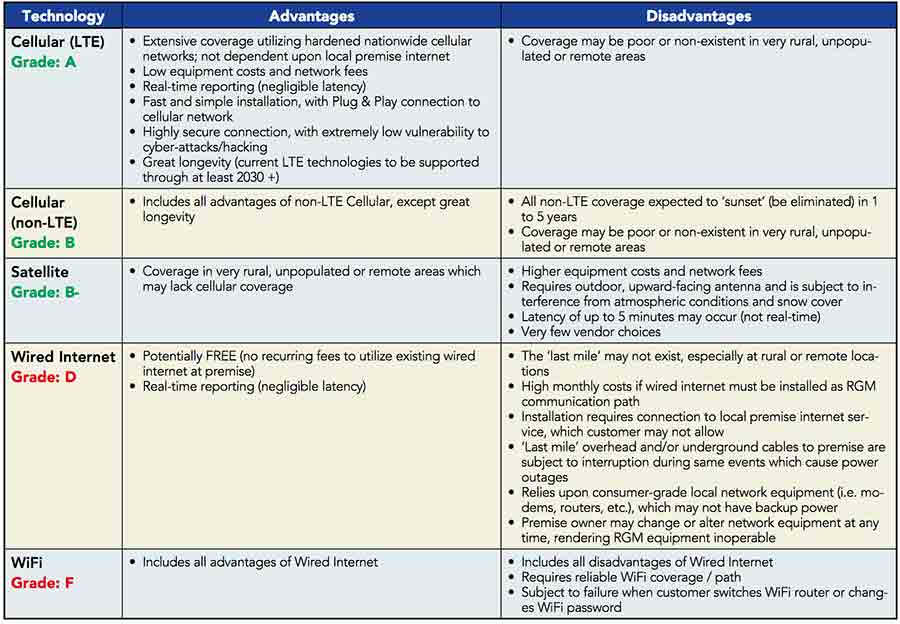
Understanding the differences between the various communication technologies will help generator maintenance companies make informed decisions about which generator monitoring solutions they install for various applications. By choosing the right solution for each application, you can improve maintenance scheduling and increase revenues, while also boosting customer satisfaction.
Remote Generator Monitoring (RGM) has become increasingly popular over the past decade, which is not surprising, since it provides substantial benefits to generator maintenance companies and generator owners. A wide array of RGM solutions are avail-able, both “OEM” (generator manufacturer specific) and “universal” (works with most generator makes and models) types, with a wide range of both complexity and cost.One of the most important factors to consider when choosing an RGM solution is the communication technology used to send data from the generator being monitored to the monitoring vendor. This white paper will explore the various communication technologies utilized by the RGM solutions currently available, and the communica-tion technologies will be compared on four critical attributes:

Read on to find out why these communication technologies earned these grades, the advantages and disadvantages of each technology, and the best communication technology to select for various RGM applications and scenarios.
Cellular: Public cellular wireless networks offering ‘nationwide’ or regional coverage for telephone and data services, which are oper-ated by major cellular carriers (e.g. AT&T, Sprint, Verizon, etc.)
Communication Technology: Method used to communicate data from the generator monitoring device (located at or near the generator) to the RGM service vendor.1
‘Last Mile’: The connection from the major network ‘back-bone’ to the premise. May be wired or wireless and may be longer or shorter than a mile.
LTE: Long Term Evolution cellular communication technology. Presently, this indicates the newest and fastest cellular technology available, and is typically also described as 4G (fourth generation) by the cellular carriers. LTE indicates that the carrier is committed to continuing to support this technology well into the future, even as newer, next generation technologies (5G, etc.) will become available.
Non-LTE: Cellular technology which was deployed prior to the newest/fastest cellular technology available, and for which the cel-lular carriers do not have a commitment to longevity. This is typi-cally 2G and/or 3G technology, and carriers have already started to discontinue (or ‘sunset’) this service to make room on their networks for LTE technology. Most Non-LTE cellular will be dis-continued within 1 – 5 years, so devices which solely rely on this technology will have to be replaced.
WiFi: Technology which allows wireless local networking of devices such as tablets or smartphones and is based on the 802.11(x) standard of the Institute of Electrical and Electronics Engineers (IEEE). WiFi provides a local wireless connection or ‘gateway’ (generally under 100 feet of range) between these de-vices and the broadband internet service at a home or business and cannot supply internet service to the devices unless it can access the premise broadband service.
Wired: Communication technology which uses a ‘hard-wired’ connection to communicate data from the generator monitoring device (located at or near the generator) to the remote monitor-ing service vendor. The local area network (LAN) connection is typically an ethernet cable connected to a modem or router which receives broadband internet (wide area network, or WAN) via co-axial cable, fiber optics, etc.
Wireless: Communication technology which uses a wireless con-nection to communicate data from the generator monitoring device (located at or near the generator) to the remote monitoring service vendor. Examples include cellular, satellite, UHF and WiFi. Al-though WiFi uses a wireless path to connect the RGM equipment to the WiFi router within the premise, it relies upon a wired connec-tion from the WAN modem or router to the RGM service vendor.
This white paper does not cover local communication protocols which might be utilized by the generator monitoring device to gather data from the generator con-troller (i.e. CAN Bus, Modbus, etc.), or communication methods used to commu-nicate data from the remote monitoring service vendor to the persons or entities responsible for monitoring the generator

There are two primary types of wired communication net-works in use in North America for data, video and voice com-munications:
The ‘Cable’ and ‘Fiber’ networks are the most widely used wired systems in North American for delivering television, in-ternet, and voice services to residential and commercial premis-es. These systems typically consist of a network ‘backbone’ that utilizes fiber-optic cabling and equipment to carry vast amounts of video, audio and data at high speeds over long distances, and sub-networks which utilize copper coaxial cable or fiber-optic cable to distribute the video, audio and data to neighborhoods and individual premises. These sub-networks are also known as the ‘last mile’ of the network and consist of overhead and/or underground cabling. Connection to the internet at the premise may be wired (i.e. ethernet) and/or wireless (i.e. WiFi).
This extremely antiquated infrastructure is being phased out, or “de-commissioned” by landline telephone companies throughout the country, and as such, should NOT be consid-ered a viable communication technology for any use, including remote generator monitoring.
There are two primary types of wireless communication net-works which provide nationwide coverage in North America for voice and data communications, ‘Cellular’ and ‘Satellite’. There are many other wireless networks that use various proprietary technologies (including UHF radio networks offered by CRN Wireless), however, this white paper is focused on the Cellular and Satellite wireless networks, which offer extensive coverage across North America.
The cellular networks are terrestrial wireless networks which typically utilize many ‘cell sites’ (located on buildings, towers, etc.) to wirelessly communicate voice and data to mobile and fixed cellular devices. The network (and therefore coverage) is built around population centers and/or roadways, so coverage may be poor or non-existent in very remote and/or unpopulated areas.
Several satellite services allow for wireless communication of voice and data from mobile or fixed devices (satellite ‘terminals’) to geostationary or low-earth orbit satellites in space. Coverage is global (or nearly global), but requires an unobstructed, upward-facing antenna located outdoors.
Which communication technology is right for each application?
© CRN Wireless www.crnwireless.com
Whether your need is to power your business to keep on your production schedule or your home to keep your family safe and sound, South Shore Generator has the product diversity to meet all of your generator requirements. We are proud to sell and service generators from 2kW to 2000kW single set units and up to as large as 100MW utilizing Generac's innovative Modular Power Systems (MPS).